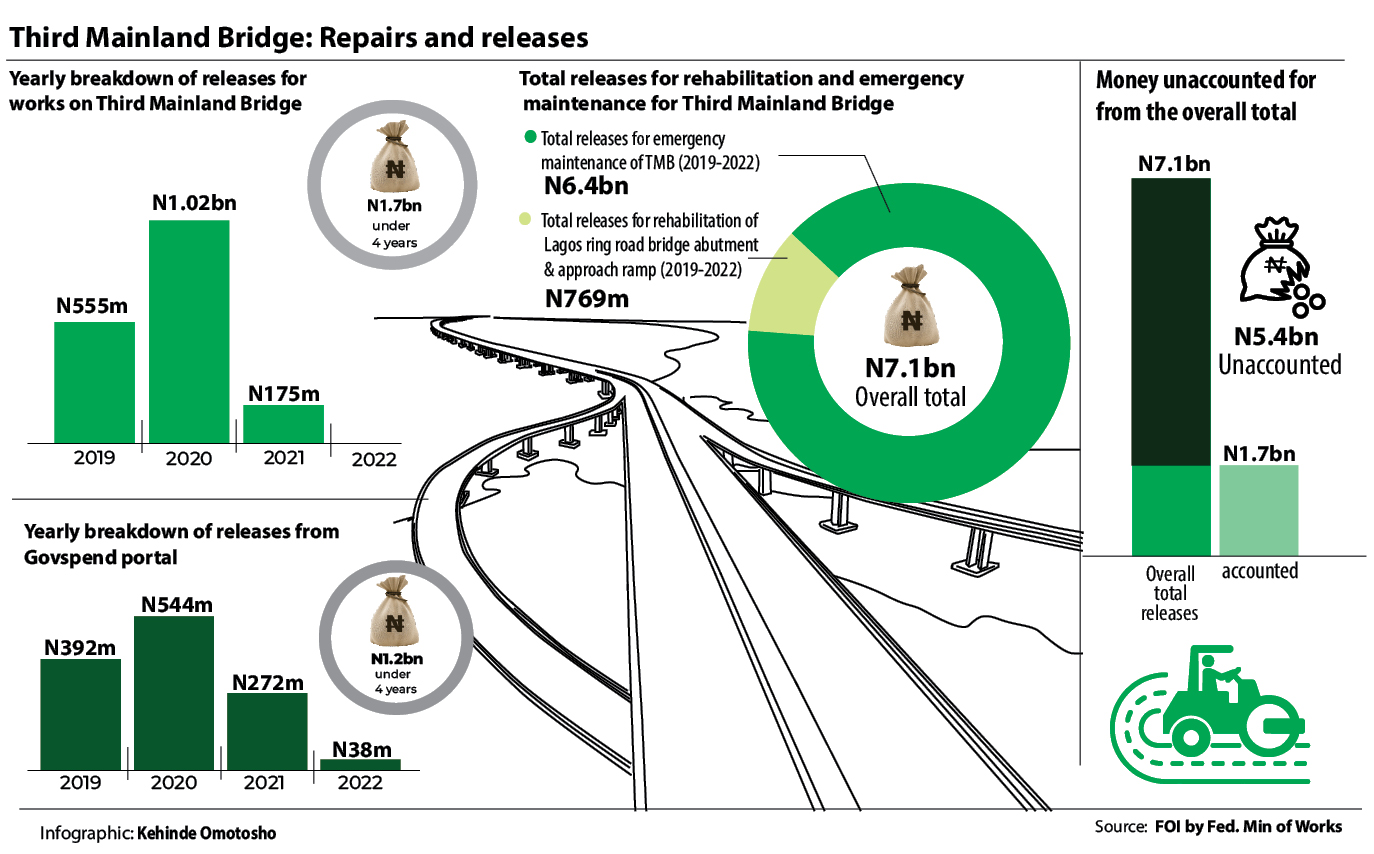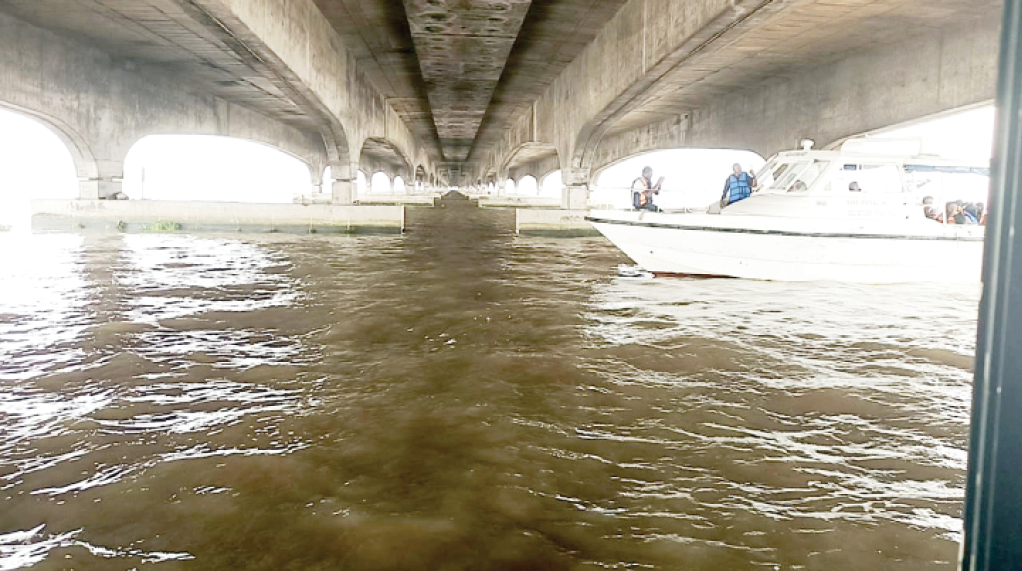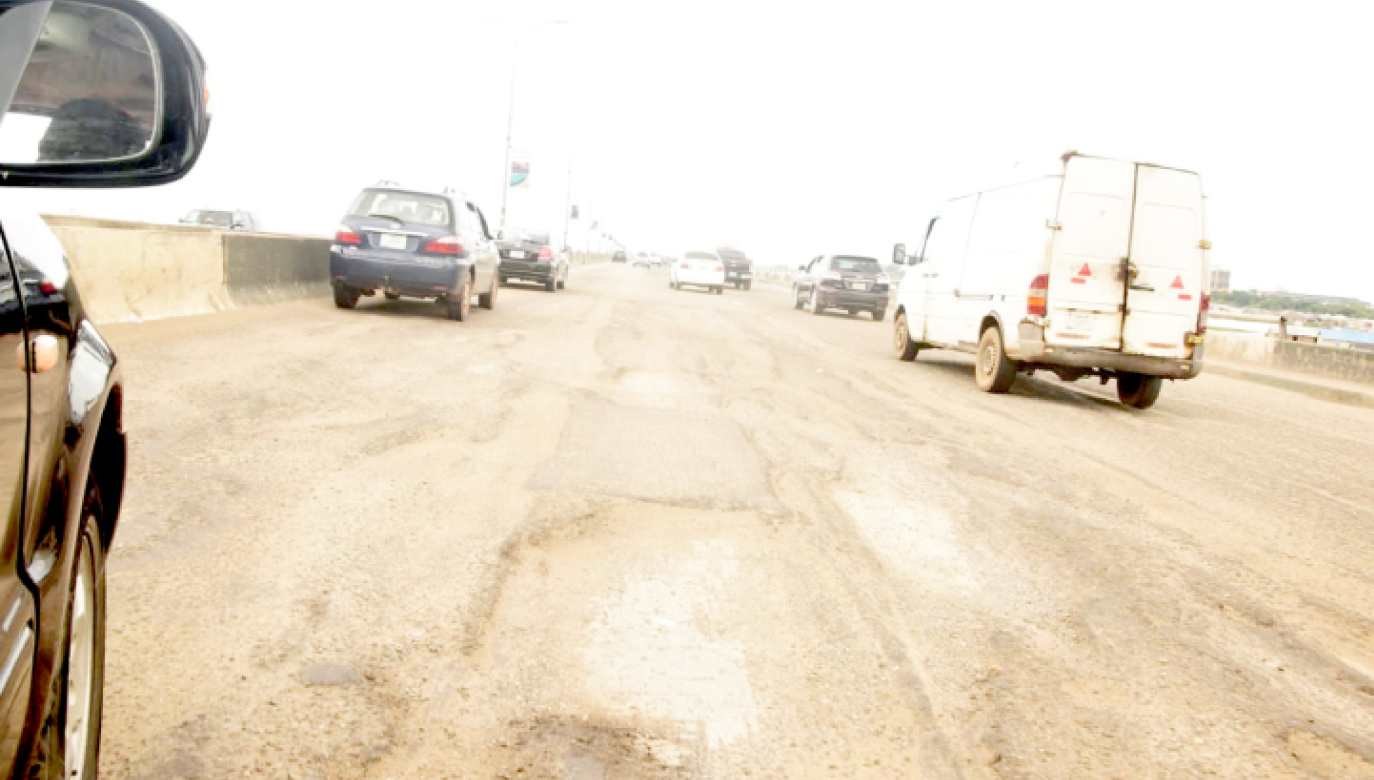After guzzling over N7bn, Third Mainland Bridge still in the works
The Lagos Third Mainland Bridge, one of the most important infrastructure facilities in Nigeria’s commercial capital, has gulped billions of naira in an attempt to maintain its structural integrity and make it safe for the millions of road users in the state. The bridge, which spans 11.8 km, is the third of the three bridges […]

after guzzling over n7bn, third mainland bridge still in the works
The Lagos Third Mainland Bridge, one of the most important infrastructure facilities in Nigeria’s commercial capital, has gulped billions of naira in an attempt to maintain its structural integrity and make it safe for the millions of road users in the state.
The bridge, which spans 11.8 km, is the third of the three bridges that connect the Mainland to the Island, with the first and second being Carter Bridge and Eko Bridge respectively.
Despite the existence of Eko and Carter bridges, residents say the Third Mainland Bridge, which was the longest bridge in Africa, until 1996 when the 6 October Bridge in Egypt was opened, remains the easiest bridge to connect the Island, especially for motorists coming from Ikeja and Ikorodu axes of Lagos State.
This is why residents continue to lament the inconveniences that come with shutting down the bridge for any repair or maintenance work, including the ongoing repair works by the federal government.
- https://dailytrust.com/third-mainland-bridge-ready-in-april-fg/
- https://dailytrust.com/fg-shuts-section-of-third-mainland-bridge-for-7-week-repair/
Until now, the Third Mainland Bridge has not undergone any major repair work, following which residents say it continued to deteriorate to the point of almost becoming a death trap.
Experts say the haphazard maintenance of the road, despite the release of billions of naira spent, as well as poor quality of materials, corrosion, overloading and vandalism, have continued to make it a source of concern.
Serving an estimated 6,000 to 9,000 vehicles on weekdays and 3,000 to 5,000 vehicles on weekends, the federal government had in January announced an advisory to commuters to use alternate routes as it commenced repair works on the Iyana Oworonshoki-Adeniji Adele bound of the Third Mainland Bridge.
Currently, the federal government has completed the Lagos Island bound section of the bridge while work on the outbound section is ongoing.
However, this report by Daily Trust on Sunday shows that the bridge, which cost about N1 billion to construct, has in the last four years gulped more than six times the amount on repair works.
The federal government had, between 2019 and 2022, allocated N7.bn for its rehabilitation, and claimed it released N6.4bn out of the approved sum. Findings from this report, however, reveal a gap of N5.4bn, which appears unaccounted for.

History of repairs, closures and diversions
From 2018 to date, this newspaper gathered that the Third Mainland Bridge has witnessed countless repairs, closures and diversions. This followed several complaints by motorists and road users about shaking expansion joints on the bridge.
In August 2018, the bridge was closed temporarily for what the federal government described as “investigative maintenance works” ahead of a comprehensive repair.
However, it was not until 2020 that the government began the repairs after videos depicting shaky expansion joints of the bridge went viral. The federal government had allayed the fears of motorists, saying while the joints were due for change, they were still safe for use and did not pose any structural danger.
It, therefore, shut down the bridge partially, diverted traffic in two phases and commenced a six-month comprehensive repair in July 2020.
Daily Trust on Sunday reports that phase one repairs of the bridge, which involved the repair of the Oworonshoki bound lane, lasted for three months.
Phase two, which was to cover repairs of the Lagos Island bound lane of the bridge, was delayed by the #EndSARS protest.
However, after seven months of the “comprehensive repair,” the bridge was reopened on February 27, 2021.
But in August 2022, the Third Mainland Bridge was again partially shut down for 24 hours for rehabilitation works on some sections said to be riddled with potholes on both sides.
Despite these repairs, the deterioration of the bridge became visible in 2023 with potholes in several sections, especially the Adeniji-bound traffic, as motorists approached the bridge from Oworonshoki.
This deterioration provided the foundation for the current repair works, with motorists now pleading with the federal government to ensure the ongoing work stands the test of time.
Speaking with our correspondent, Olusegun Oyebanjo, who plies the bridge to his place of work on the Island, decried the pain commuters faced since work began on the bridge, saying traffic had become a nightmare. “It makes commuting from point A to B harder and stressful as more productive time is spent in traffic,” he said.
Williams Kayode Gabriel, who works in Marina and lives in Ketu, also said, “I know the gridlock is for the meantime due to the construction of the bridge. It is very stressful but I have no choice. All I have to do is wake up very early and try to leave work as early as possible.”
FG allocates N7.1bn for maintenance in 4 years
Nigeria’s former military head of state, Ibrahim Badamasi Babangida, in 2017, said the Third Mainland Bridge was constructed with less than N1bn. While official government records show that the bridge was first commissioned by President Shehu Shagari in 1980, the second phase—Ebute-Metta to Oworonshoki—was commissioned by Babangida in 1990.
A comparative analysis of Nigeria’s yearly budgets between 2019 and 2023 by this newspaper indicates that maintenance and rehabilitation of the Third Mainland Bridge remains a line item under the headings: “Emergency Rehabilitation/Maintenance of Third Mainland Bridge in Lagos,” and “Rehabilitation of Lagos Ring Road Bridge Abutment and Approach Ramp to the Third Mainland Bridge in Lagos State.”
Further investigations revealed that between 2019 and 2022, a cumulative sum of N7.1bn was allocated for maintenance and repair of the bridge.
The 2019 budget shows that a provision of N200 million was made for the “Rehabilitation of Lagos Ring Road Bridge Abutment and Approach Ramp to the Third Mainland Bridge in Lagos State C/No 6200.” But within the same budget year, another sum of N1bn was allocated for “Emergency Rehabilitation/Maintenance of the bridge “Part I, (Restoration of Defective Substructure piles (Underwater) C/No 6238.”
In 2020, the federal government budgeted N250million for C/No 6200 and N1bn for C/No 6238. For the 2021 budget, the same line items appeared with N175m and N4bn respectively allocated in that fiscal year. However, in the 2022 budget, the federal government allocated N134m and N409m respectively for the same line-items listed as ongoing, amounting to a total of N7.1bn allocated for the project in four years.
Fears over N5.4bn from FG’s releases
In an attempt to track details of funds released to contractors for the Third Mainland Bridge project, our correspondent filed a Freedom of Information (FOI) request to the Federal Ministry of Works on January 11, 2024 and got a response on February 9, 2024.
In the document released to this newspaper and signed by the ministry’s Director of Planning, Research and Statistics, Kolapo Raheem, the federal government stated that the contract for the Third Mainland Bridge rehabilitation projects was awarded in 2012 at a cost of N18.8bn and 967m.
The two projects are the “Emergency Rehabilitation/Maintenance of Third Mainland Bridge in Lagos part 1,” with contract number C/No 6238 and “Rehabilitation of Lagos ring road bridge abutment and approach ramp to the Third Mainland Bridge in Lagos,” referred to by its contract number, C/No 6200.
According to the document, for C/No 6238, a total of N6.4bn was released/paid between 2019 and 2022 while N769m was released/paid for C/No 6200 between 2019 and 2022. The two releases amount to N7.1bn released to Borini Prono and Company Nigeria Limited in four years.
But the breakdown of yearly releases within the period under scrutiny, when computed by this reporter, gave a total of N1.7bn against the N7.1bn for both C/No 6238 and C/No 6200 as stated by the Federal Ministry of Works in the FOI.
The yearly breakdown as indicated in the FOI showed that in 2019, the federal government had appropriated N816.8m for C/No 6238 but released N555m, while it appropriated N181.5m for C/No 6200 but did not make any release.
The FOI also showed that in 2020, the federal government appropriated N893m for C/No 6238 and released the entire amount while it appropriated N133.9m for C/No 6200 and also released the entire amount.
In 2021, the FOI gave a breakdown of N4bn being allocated for C/No 6238 while no releases were made for that year. It also showed that N175m was allocated for C/No 6200 and the entire amount was released for the project.
In the one-page FOI document titled, “Status of Allocation for the Third Mainland Bridge Project from 2019 to 2022,” it showed that N409m had been allocated for C/No 6238 while N134m was allocated for C/No 6200 in 2022. It further showed that no releases were made for the year.
However, in an attempt to understand the missing link in the data, this reporter conducted further checks on govspend.ng, a comprehensive portal that provides citizens access to visualised and simplified data from the federal government’s Open Treasury Portal. The portal could, however, only track a total of N1.2bn released by the federal government for the maintenance of the bridge in the last four years.
The yearly releases from 2019 to 2022 on the govspend portal showed that in October 2019, the federal government paid N167m to Borini Prono Company as part payment for the “emergency rehabilitation maintenance of the Third Mainland Bridge in Lagos, part 1 (restoration of defective substructure pile under water), which is C/No 6238.”
Again, in December, 2019, N184m was also paid to the same company under C/No 6238 and another N41m paid to the company within the same month.
In 2020, govspend showed that the sum of N232m was paid again to Borini Prono and Company Ng Limited in February, 2020 and another N218m paid to the same construction company in April of the same year under C/No 6238. Still in May, 2020, govspend tracked another N7m paid to Icecon (Nig) Ltd for “the re-confirmatory test of the echo metric tests, underwater inspection and assessment of pilings of the Third Mainland Bridge.” This line item and the company were not indicated in the FOI document presented to this newspaper by the Federal Ministry of Works.

Also, in October 2020, another N87m was paid to Borini Prono and Company Ng Limited under the same C/No 6238.
For the year 2021, the govspend portal showed that in January 2021, the sum of N116m was paid to Borini Prono and Company Nig Limited for C/No 6200. Similarly, in May 2021, the portal showed that another N107m was paid to Borini Prono and Company Ng Limited and another N49m to the construction firm in October of the same year for C/No 6200.
In 2022, the govspend portal showed that in June 2022, N38m was paid to Nexant Consulting Limited “for the engineering supervision of the emergency rehabilitation of the Third Mainland Bridge in Lagos State.”
Daily Trust on Sunday, however, noticed that this line item and the company were not stated in the FOI document presented to this newspaper by the Federal Ministry of Works.
When contacted to explain the inconsistencies in the releases made by the federal government between 2019 and 2022, the Director of Information in the Ministry of Works, Mr Olusola Abiola, said he was still new in the ministry and directed our correspondent to the FOI desk officer in the ministry.
This reporter informed Mr Abiola that the FOI had been signed by Kolapo Raheem, the Director, Planning, Research and Statistics in the ministry and asked for his contact. However, since then, Mr Abiola has failed to respond to calls and text messages sent to him.
Experts blame bridge deterioration on haphazard maintenance
Sources familiar with the maintenance work of the Third Mainland Bridge told this reporter that previous works on the bridge were not comprehensive, which would explain the deterioration.
“The last time we did it, we didn’t cover the entire section of the bridge, and I am sure that is what the government wants to continue to do,” said a source from the ministry who asked to remain anonymous as he was not authorised to comment on the issue.
In addition, another source in the ministry said the activities of sand dredgers had weakened the bearings of the bridge in the under-decks.
“When you check under the bridge, you see that a lot of sand dredging is going on, and this is affecting the bearings and the foundation of the bridge,” the source said.
However, a former president of the Nigeria Institute of Structural Engineers (NISE), Victor Oyenuga, said while the bridge is old and requires regular maintenance, there was need to have in place a scheduled maintenance programme that would be followed to the latter, instead of the haphazard maintenance works.
“We are talking of a bridge close to 40 years now, and this is a bridge vehicles use every day. Lack of scheduled maintenance programmes is the crux of our problem. Let there be a maintenance schedule for all the various parts: the bearings, the joints and the surfacing itself, and we don’t have to wait for anything to happen before we carry out the maintenance. It would be cheaper than to reconstruct it,” he said.
Also, a former chairman of the Nigerian Society of Engineers (NSE), Ikeja Branch, Lagos State, Akin Akintola, said the annual budgeting for the Third Mainland Bridge should be called to question.
“Who is really monitoring some of these things? Did they really carry out the maintenance? What they have been doing is surfacing. Apart from resurfacing, I don’t see much work they are doing.
“They kept doing maintenance and the maintenance they are doing is more surfacing. How much are they doing per square meter or kilometer? Why are you shutting it down every now and then? Could it have become a cash cow?” he queried.
The Federal Controller of Works, Olukorede Kesha, however, explained that previous maintenance works on the bridge had not been comprehensive, stressing that this led to the fresh shutdown of the Oworonshoki-Adeniji-bound lane of the bridge in January for eight weeks.
This story was sponsored by the Daily Trust Foundation with support from MacArthur Foundation.
